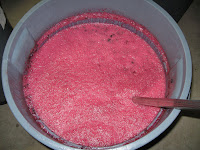It's recap time tonight, so let's continue with the fermentation. When last we left, everything was crushed and chillin' overnight. On Tuesday night, I came home and got serious about must analysis and yeast innoculation. Numbers weren't all that bad
Merlot: brix = 21.0, PA = 11.6%, pH = 3.50, total acidity = 7.5 g/L
Cabernet franc: brix = 22.2, PA = 12.2%, pH = 3.42, total acidity = 7.1 g/L
Lemberger: brix = 21.6, PA = 11.9%, pH = 3.22, total acidity = 8.6 g/L
Zinfandel: brix = 28, PA = 15.4%, PA = 3.75, total acidity = 6.4 g/L
The WA grapes (merlot, cab franc, & lemberger) are a little lower brix & a little more acidic than I would have liked. On the other hand, the zin is a sugar powerhouse! I decided to leave the cab franc and the lemberger alone. The cab franc is in decent sugar space, while the lemberge is akin to a pinot noir so should be a little lower alcohol in my opinion. The merlot definitely needed some sugar, so I added sugar to reach brix = 23.0 (PA = 12.7%). The zinfandel definitely needs some amelioration to lower the sugar levels, so i added some acidulated water to lower the brix to about 25.6 (PA = 14%). That's a fancy way of saying that I added some tartaric acid to the water to make it about 6.5 g/L in total acidity so that we don't dilute the acid levels while fixing the sugar levels.
I'm going for a Right Bank Bordeaux blend with the merlot and cab franc so I chose to use Lalvin MT yeast strain that was isolated in Bordeaux and is supposed to emphasize the typical merlot flavors and aromas. I bought a big bag and used it for the merlot, cab franc, and lemberger (mainly because I had extra). For the zinfadel, I decided to use VQ-15 Rockpile yeast--a strain that was isolated from zinfandel fermentations in the dry Rockpile AVA. Since the zinfandel was dry-farmed in similar rocky conditions in the Sierra Foothills, I thought this yeast would be a good complement and really punch up those jammy zinfandel flavors.
After innoculation, the cooler temperatures kept things fairly slow. It took about 48 hrs before the skin cap started to form on the wines and after that it was a pretty slow, but steady fermentation. I added both DAP and Fermaid K after the lag phase and at 1/3 sugar depletion. Used a little extra than normal because the ferment was a bit stinky as a lot of darker thiol aromas were blown off during punch downs. The must temperatures never got above 65 °F or so due to the cold temps in my garage.
The merlot, cab franc, and lemberger finished fermentation after about 9 days, while the zinfandel was a little extra pokey. After 9 days, the zinfandel was still at brix = 6.4. But since I was getting all the gear out and cleaned, I decided to press everything on the same day and let the zinfandel finish in the carboy.
Next post please...
Cheers,
Noel


No comments:
Post a Comment